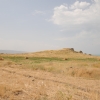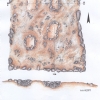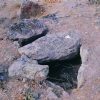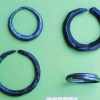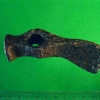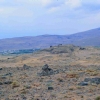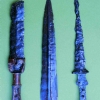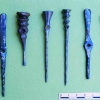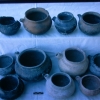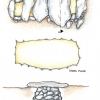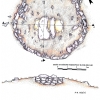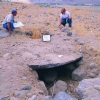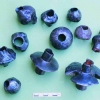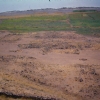The Ernis-Evditepe Fortress and the Necropolis area are located on the northeast end of the Lake Van, 18 km east of the Erciş district and within the borders of Ünseli Village.
The fortress located at an altitude of 60-70 m from the plain level, extends in the northeast-southwest direction, according to the topographic structure of the hill on which it was built. It is understood that the main settlement areas of the fortress are in the southern part. In the southwestern and southeastern parts of this section, there are defensive walls made of large unprocessed large stones. In other areas there are traces of burial and settlement remains.
In the excavations carried out by Prof. Arif Erzen in the Necropolis of Ernis, it is understood that a total of 9 graves were opened. As it can be understood from the excavation reports, more than one burial was made in the burial chambers.
In a one of the graves, close to 80 pots indicate that the number of burials is quite high. A large number of skulls and human bones were identified in the burial chambers, which were reported to be at various levels. In the excavation reports, it was stated that there were many bead necklaces, iron ornaments and weapons in these burial chambers.
Considering the architectural features of the Ernis-Evditepe tombs, two main groups emerge clearly. The burial chambers surrounded by a circular stone sequence (Kromlek) have differences from the Early Iron Age and the Urartian graves, which have been determined by their architectures and burial insights.
Among the graves in the Ernis Necropolis, the second large grave group consists of one-room burial chambers with rectangular plan reflecting the type of plan we know very well from the Urartian graves.
The burial chambers were built with stone walls built into pits that opened to the ground. Almost all of the side-long walls were built in the thrust technique; grave chambers, large and flat stone blocks of the upper cover were formed. The grave chambers, which were without dromos, could be entered with the removal of the cover stone forming the upper cover and possibly on the side of the short wall. In addition, the excavation reports indicated that the burial was made by entering a tomb chamber through a door on a narrow short wall.
A second necropolis area identified by Afif Erzen is located at the west of the Teacher Alparslan School in Alacahan, just to the east of Ernis. In this area, a fortress with worm-toothed walls was found in the flattened areas with terraces showing the architectural features of Urartian. Although the burial chambers uncovered outside the fortress were stated to be different from Ernis graves in terms of architecture, it was stated that there was no much temporal difference in chronological order. A grave chamber uncovered in this area has a height of 6.60 m and a height of 3.25 m and a height of 2.80 m.
